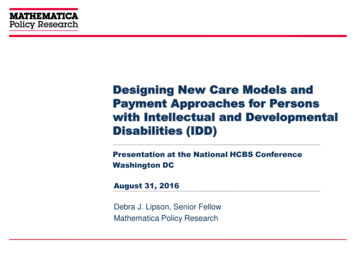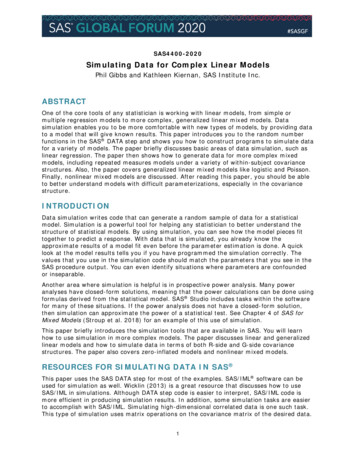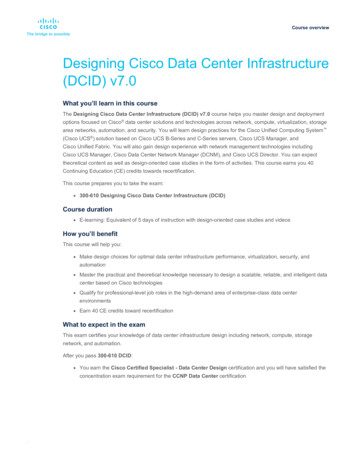
Transcription
Designing New Care Models andPayment Approaches for Personswith Intellectual and DevelopmentalDisabilities (IDD)Presentation at the National HCBS ConferenceWashington DCAugust 31, 2016Debra J. Lipson, Senior FellowMathematica Policy Research
Agenda Drivers of Innovation for Care and Services forPeople with IDD– Debra Lipson, Mathematica Care and Payment Innovations in Tennessee– Patti Killingsworth, TennCare Learning from the FIDA-IDD Partnership in New YorkState– JoAnn Lamphere, New York Office for People withDevelopmental Disabilities Discussion2
Current IDD Care Model People with IDD living in the community mostly receivesupport services, including residential care, throughMedicaid HCBS waivers– Long waiting lists Average length of time spent on a waiting list was 47 months for I/DD waivers in2012 In June 2013, an estimated 232,204 people with IDD were waiting to receiveMedicaid LTSS services– LTSS not integrated with medical care and behavioral health People with IDD have higher rates of epilepsy, neurological and gastrointestinaldisorders, diabetes, and behavioral/psychiatric problems; living longer and aging Primary care providers, medical specialists, and other clinicians who care foradults often get little or no training in intellectual or developmental disabilities Even in states that enroll individuals with IDD in managed care, most do so onlyfor acute care Individuals with IDD typically receive little or no preventive care3
Current IDD Care Model Quality and outcomes could be better Nearly all (90%) people like where they live, but 26% want to livesomewhere else * Just half (54%) of people with IDD choose where they live, less than half(45%) choose who they live with, and only 17% have a paid job in thecommunity * People with IDD typically have a shorter life expectancy than peoplewithout disabilities, increased morbidity, and greater rates of cooccurring conditions* NCI 2014-15, Adult consumer survey (31 states, DC and one regional council)4
People with IDD need extensive servicesIn 2012, people withI/DD accounted for: 41% of total HCBSwaiver enrollment But 72% of spending Per participantspending for personswith IDD was( 47,522) -- morethan 4 times higherthan average waiverspending for agedand disabledindividuals ( 11,600)5
Costs are unsustainable IDD population expected to grow– Prevalence of developmental disabilities has increased 17% in2006-2008, compared to a decade earlier (CDC)– People with IDD are living longer; the number of adults withIDD over 60 years of age is projected to nearly double from641,860 in 2000 to 1.2 million by 2030 Current payment models do not encourage orpromote efficiency6
MLTSS delivery and financing reform State MLTSS programs for people with IDD– In 2012, 4 states had sizable MLTSS programs Arizona, Michigan, North Carolina, Wisconsin Capped LTSS spending – total or per person No fundamental change to traditional IDD service system– 2013-2016 – 11 more California, Delaware, Hawaii, Illinois, Kansas, Massachusetts,New York, New Mexico, Ohio, Rhode Island, Virginia– Texas is in the midst of a multi-year developmentprocess to enroll people with IDD into STAR PLUS7
Other delivery and payment reforms Medicaid – integrated or coordinated medical andbehavioral health services– Patient-centered medical homes– Medicaid health homes– Pay-for-performance and value-based contracts with managed carenetwork providers– Accountable Care Organizations – shared savings LTSS largely excluded now, but some of thesemodels are exploring partnerships with LTSS8
How to adapt these models? Applying these new models to LTSS forpeople with IDD requires significantadaptation:– Care systems and providers are very different– IDD providers lack experience with managed care,ACOs, etc.– MLTSS plans lack experience and understanding ofIDD population and services– Different quality and performance metrics for IDDservices9
TN and NY Trailblazers Both feature elements of MLTSS, but pursuingdifferent approaches Common features:– Grounded in person-centered care principles– Payment rates to providers established by state– Payment incentives for delivering more efficient and effectivecare that aligns with individual goals and program objectives– Comprehensive benefits (inclusive of physical, behavioralhealth, and LTSS) Differences:– Funding – Medicaid-only versus Medicare and Medicaid NY model integrated with Medicare benefits for dual enrollees10
TennesseePatti Killingsworth11
New YorkJoAnn Lamphere12
Discussion13
For More Information Debra Lipson– DLipson@mathematica-mpr.com Patti Killingsworth– Patti.killingsworth@tn.gov JoAnn Lamphere– joann.x.lamphere@opwdd.ny.gov14
Designing New Care Models and Payment Approaches forPersons with Intellectual and Developmental Disabilities:Care and PaymentInnovations in Tennessee
Service delivery system in Tennessee TennCare managed care demonstration began in 1994 Operates under the authority of an 1115 demonstration Entire Medicaid population (1.4 million) in managed care since1994 (including individuals with I/DD) Three health plans (MCOs) operating statewide Physical/behavioral health integratedbeginning in 2007– Managed LTSS began with the CHOICES program in 2010– Older adults and adults with physical disabilities only– LTSS (3 Section 1915(c) waivers and ICF/IID services) for individuals withI/DD have been carved out(people are carved in for physical and behavioral health services)– New MLTSS program for individuals with I/DD began July 1, 2016:Employment and Community First CHOICES
Opportunities to improve delivery of I/DD servicesFragmentation:(includes 75% ofpeople with I/DDreceiving LTSS)Accountfortotal50% ofprogramcostsTennesseespends nearlythe national average perperson for this population2xCHOICES Program ID Services*7,900*Includes HCBSWaivers and ICFs/IIDThat’s 40,000 1.2 billion 936 millionServes 30,000people who areelderly or havephysical disabilitiesServes 9,000people who haveintellectualdisabilitiesIncreased Demand for Services:Waiting ListTennCare3% ofmembersLittle coordinationbetween physical andbehavioral healthservices and longterm services andsupports (LTSS)Receiving ServicesCost:per personVS 106,000per person6,200Almost as manypeople on thewaiting list toreceive Homeand CommunityBased Services(HCBS) as thoseactuallyreceivingservicesInsufficient EmploymentOpportunities:Significant gap betweenpeople with ID whowant to work and thosewho are actuallyworkingSome people withdevelopmentaldisabilities aren’treceiving HCBS
Opportunities to improve delivery of I/DD servicesCreate a new MLTSS program that will: Provide the services people and their families say they need most Allow us to provide services more cost-effectively Serve more people, including people on the waiting list andpeople with other kinds of developmental disabilities Align incentives toward employment, independent living,community integration and the things that people with disabilitiesand their families value most Build health plan and system capacity for person-centered practices
Stakeholder engagement Commenced in December 2013o Meetings with advocacy and provider groupsJanuary-February 2014o Regional community meetings with consumers, family members, providerso Online survey toolFebruary-March 2014o Written comments and other follow-up recommendationsMarch 26, 2014 - Stakeholder Input Summary issuedMay 30, 2015 - Concept Paper posted for public commentJune 2014o Regional community meetings with consumers, family members, providerso Online survey toolo Consumer/family-”friendly” summaries of the Concept Paper disseminatedand posted onlineJuly 18, 2014 - Stakeholder Input Summary on Concept Paper issuedJune 23, 2015 – 1115 Waiver amendment
Employment and Community First—benefits 3 benefit groups (designed based on services individualsand families say they need most) include:– Essential Family Supports – supports for families caring fora person (primarily children under age 21) living at home withtheir families to help them plan and prepare for transition toadulthood– Essential Supports for Employment and Independent Living –targeted to young adults aging out of school to support transitioninto integrated, competitive employment and independentcommunity living– Comprehensive Supports for Employment and CommunityLiving – for people who need more support to help them achieveemployment and community living goals and experiencecommunity life Benefit limits and expenditure caps help to ensure efficiency
Employment and Community First—benefits Array of employment services and supports Designed in consultation with experts from the federal Office onDisability Employment Policy Create a “pathway” to employment, even for individuals withsignificant disabilities Outcome or value-based reimbursement and other strategies toalign incentives toward employment Wrap around services to support community integration No facility based services Many new services, based on stakeholder input, that willempower individuals and families toward independence andintegration Residential services available when needed
ECF CHOICES Benefits*14 different employment services/supports1. Exploration2. Discovery3. Situational Observation and Assessment4. Job Development Plan5. Self Employment Plan6. Job Development Start Up7. Self-Employment Start Up8. Job Coaching for Individual Integrated Employment9. Job Coaching for Self-Employment10. Co-Worker Supports11. Supported Employment – Small Group12. Career Advancement13. Benefits Counseling14. Integrated Employment Path Services (Pre-Vocational)Plus employment wrap-around services like: Independent Living Skills Training Community Integration Support Services Community Transportation* Not all services are available in every benefit package.Supportive services Personal Assistance Community Living Supports Community Living Supports-Family Model Assistive Technology, Adaptive Equipment and Supplies Minor Home Modifications Specialized Consultation and Training Adult Dental ServicesFamily caregiver supports Supportive Home Care (SHC) Family Caregiver Stipend (in lieu of SHC) RespiteFamily empowerment supports Family Caregiver Education and Training Family-to-Family Support Community Support Development, Organization and Navigation Health Insurance Counseling/Forms AssistanceAnd self-advocacy supports Individual Education and Training Peer-to-Peer Person-Centered Planning, Self-Direction,Employment, and Community Support and Navigation Conservatorship and Alternatives to Conservatorship Counselingand Assistance
Other I/DD Care and Payment InnovationsInitiatives toReduceTargetedreductions inInappropriateInitiativesto RedUse ofPsychotropics Partnership with I/DD agency andUCED to create toolkit andtraining for physicians, peoplewith I/DD, and families IDDToolKit.org Appropriate Use ofPsychotropic Medicationsfor People with IDD: HelpingIndividuals Get the BestBehavioral Health CareNew pharmacy priorauthorizationrequirements for psychotropicmedicationsBehavioral Health CrisisPrevention, Interventionand Stabilization Services Implemented in March 2016Delivered under managed careprogramFocus on crisis prevention, inhome stabilization, sustainedcommunity living and building aperson-centered “system ofsupport” (“SOS”)Reimbursement aligned tosupport improvement andindependenceTechnology platform tracksoutcome measures to establisha value-based purchasingcomponent (incentive or sharedsavings) for reimbursementI/DD Health Homes Begin with I/DD-specific behavioralhealth home in 2016 Leverage technology platform andtelehealth to ensure timely access topsychiatrists and behavioral healthproviders with expertise servingindividuals with I/DD Implement comprehensive I/DD healthhome in 2017 Interdisciplinary approach to carecoordination/delivery across physical,behavioral health, pharmacy, dentaland LTSS Education, training and support forcommunity (including LTSS) providers
Thank you
Learning from the FIDA-IDDPartnership in New York StateNational HCBS Conference, NASUADWashington, DCAugust 31, 2016
2A Partnership with NationalSignificance OPWDD is partnering with NYS Department of Health(DOH) and the federal Centers for Medicare andMedicaid Services (CMS) to offer a unique program topeople with intellectual and developmental disabilitieswho receive services through Medicare and Medicaid A part of CMS’ dual demonstration initiative – NYS isunique in its focus on IDD in one FIDA
3What is the FIDA-IDD Fully Integrated Duals Advantage program for individualswho have Intellectual and Developmental Disabilities One health plan that brings together Medicare, Medicaidand Waiver HCBS developmental disability services A personal health care plan that’s centered on theindividual A health plan that gives one all the care and supportsneeded in one place Services are provided by a network of providerscontracted with the health plan Partners Health Plan (PHP) is the only plan selected byCMS to offer the FIDA-IDD program: PHP grew fromdownstate ARC consortium
4FIDA-IDD Implementation FIDA-IDD plan delivering integrated health and long term carebenefits to individuals with Medicare and Medicaid who residein targeted geographic area and who choose to participate inthe Demonstration. Target area - NYC, Nassau, Suffolk, Westchester, Rockland Target population (n 20,000 adults) Enrollment in FIDA available in all targeted counties; no phasedimplementation and no passive enrollment Plan is responsible for coordination of all the individual’s services(Medicare acute, Medicaid, specialty OPWDD services, and any othersrequired to meet the individual’s needs) FIDA-IDD Demonstration period is from April 2016 -- December 2020 Enrollment is voluntary
5FIDA-IDD Offers ComprehensiveBenefits & Services Medicare primary care, physician & specialtyservices, hospitalization, prescription drugs Medicaid Care ManagementLong Term Supports & ServicesBehavioral HealthOPWDD waiver services if already enrolled in the 1915(c)HCBS Waivered Services Pharmacy and Dental Other (residential) Enrollee can self-direct
6What’s Different About FIDA-IDD Health Plan provides person centered care managementand comprehensive health coverage – not bouncedbetween Medicare & Medicaid Individuals enrolled actively participate in planning fortheir medical, behavioral, long-term services & supportsand social needs -- develop a “Life Plan” (service plan) Individual has a Care Manager and an InterdisciplinaryTeam (IDT) to help plan, coordinate and assistindividuals in accessing services & supports, improvingquality of life & accomplishing life goals The IDT/ Plan is responsible for making coveragedeterminations as part of service planning
7What Else Makes FIDA-IDD Unique Capitated to provide Medicare, Medicaid, Part Dand Medicaid drug benefits No deductibles, premiums, copays orcoinsurance cost to enrollees One benefit card to access all services Person Centered Planning Team Additional outside supports through the newOmbudsman
8FIDA-IDD Milestones FIDA-IDD MOU signed 11/ 2015 FIDA-IDD CMS press 15-11-05.html Three-way contract among PHP, State and CMSexecuted 1/ 2016 Go live April 1, 2016; now nearly 300 enrollees
9Care Coordination is a SystemCentralPoint ofContractEligibility& areCoordinationFunctionsCoordination dKeeping
10PHP Coordination Tool & IT Supported Partners Health Plan (PHP) designed and uses a stateof-the-art tool to support person-centered planning andcare coordination, with IT enabled communication anddata collection (quality metrics) The vision of person-centeredness anchors assessment,development of Life Plan, activation of InterdisciplinaryCare Team, authorization of services, monitoring deliveryof supports, data analysis, etc. Technology application (not usual in IDD world) createsefficiency in coordinating activities, monitoring resultsand achieving desired results
Hallmarks of aPerson Centered Approach Assessment Life Plan Portal The person’s activities, services and supports are based uponhis or her interests, preferences, strengths and capacitiesThe person and people important to him or her are included inlifestyle planning, and have the opportunity to exercise controland make informed decisions.The person has meaningful choices, with decisions based onhis or her experiences.The person uses, when possible, natural and communitysupports.Activities, supports, and services foster skills to achievepersonal relationships, community inclusion, dignity andrespect.The person’s opportunities and experiences are maximized,and flexibility is enhanced within regulatory and fundingconstraints.Planning is collaborative, recurring, and involves an ongoingcommitment to the person.The person is satisfied with his or her activities, supports, andservices.11
I/DD ManagedCarePHP Care Coordination Integration PackPHPNotificationof ChangeReview ofProgress /Analytics“It’s All AboutMe”AssessmentPHP LifePlanManaged CarePHP Model of CarePHPMonthlySummaryPHPCharting,Daily GoalsandSupportsHabilitationPlan, ActiveTreatmentPlan, IPOP 2015 MediSked, LLC, Life Care Data Exchange, Inc, Partners Health Plan, Inc. - All rights reservedProvider Agency
13Benefits to Consumers Increased individual satisfaction and choice through personcentered planning Service authorization, activation and monitoring with reducedpaperwork Improved access to services and providers and reduction ofunnecessary delays Enhanced integrated opportunities for independence to the extentpossible Support of meaningful outcomes and value-based performancemetrics IT enabled communication Increased system accountability
63 Core Quality Measures for FIDA-IDDFIDA-IDD Specific measures: Council on Quality and Leadership, Personal Outcome Measures(POMs) and some other metricsOthers largely from Medicare Advantage measures: Behavioral Health-e.g., screening for clinical depression & follow-up careTransitional Services-e.g., care transition record transmitted to healthprofessional, medication reconciliation after discharge from facility, real timehospital admission notifications, discharge follow-upEnroll Ranking of Quality of Care-e.g., rating of plan by individualCustomer Service-e.g., timely processing of appeals, complaints about theplanService and Goal Realization-e.g., documentation of care goals, P-C LifePlans, self-direction participation, institutional diversionCare for Older Americans-e.g., medication review, functional statusassessment and pain screeningPreventive Health- e.g., risk of falling, controlling blood pressure, diabetesrelated exams, flu vaccine, cancer screening
15Benefits and Challenges of ProviderParticipation Providers are an essential conduit for information toindividuals (and families) in voluntary enrollment Extensive outreach by Partners Health Plan and State toIDD providers: No financial risk to providers when they enter intocontract agreement Providers that are first to table gain valuableexperience, potential to increase clients, support andtraining from PHP Provider participation remains challenging; many IDDLTSS providers are not yet participating
16Still Learning How to SupportIndividual Choice How to more effectively communicate withpotential enrollees What really matters to them How overcome bias of status quo Who makes the decision to enroll What LTSS quality and outcome metricsare most meaningful to track
17Questions?JoAnn Lamphere, DrPHDeputy CommissionerOffice of People With Developmental 9697Or FIDA-IDD@opwdd.ny.gov
2 Agenda Drivers of Innovation for Care and Services for People with IDD -Debra Lipson, Mathematica Care and Payment Innovations in Tennessee -Patti Killingsworth, TennCare Learning from the FIDA-IDD Partnership in New York State -JoAnn Lamphere, New York Office for People with Developmental Disabilities Discussion










